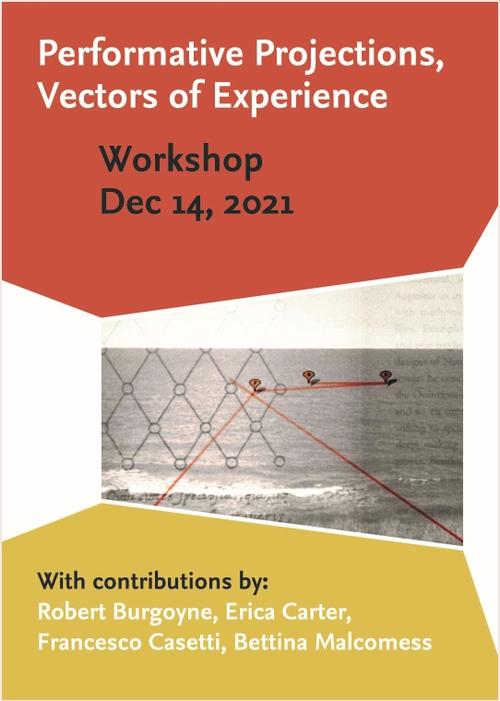Performative Projections, Vectors of Experience
14.12.2021 | Digitaler Workshop der Kolleg-Forschungsgruppe Cinepoetics mit Robert Burgoyne, Erica Carter, Francesco Casetti und Bettina Malcomess.
Research Focus: Projection, Reflection, and Experience
The workshop aimed to develop a shared perspective on the work of our late colleague Eileen Rositzka, specifically her insights on cartographies as a poetic practice of cinematic thinking. Mapping is usually conceptualized according to the mathematical laws of cartographic projection. With regard to cinematic cartographies, however, maps become performative practices that render the act of film viewing a cultural and phenomenological process. The workshop explored modes of embodied navigation through cinematic worlds, with mapping understood as a poetic practice of transforming a text into an experiential space.
In the first talk, Francesco Casetti recalled several discussion points with Eileen Rositzka on the relation between maps and the process of mapping. First, he referred to the difference between the notions of the map as representation and as a set of operations. The second discussion point concerned two aspects that Rositzka tried to merge in her doctoral research, namely mirroring reality and envisioning reality. These aspects expressed themselves in the question of whether the map is prompted by territory or vice versa, meaning the territory as the effect of the map. The third point treated the question of the map as a product of the human gaze or human agency as a product of the map. Casetti then pointed out the difficulty of entangling these questions with each other in a coherent argumentation. He mentioned that in his discussions with Rositzka, she favored the definition of trajectories rather than establishing fixed coordinates. She also insisted on defining the territory in which the subject is inscribed as a result of the map. Afterwards, Casetti brought up the difficulty of locating the agent of the map in an individual, collective, or institutional sense and concluded with the open question of the map as an instrument of subjectivization.
In his analysis of THE REVENANT (Alejandro Iñárritu, USA 2015), Robert Burgoyne focused on three interrelated spheres shaping his thesis of the film's activity of unmapping and remapping. First, Burgoyne gave an overview of the history of landscape painting and its image of the American West as unpeopled. Filled with ideological charge, paintings such as the works of Albert Bierstadt show the landscape as picturesque, empty, and pastoral, encouraging white settlers to migrate and take possession of the land. In THE REVENANT, however, the land is overpowering, as non-human sounds dominate the soundtrack. The second sphere in Burgoyne's talk concerned the film's play with scale, leading to a dislocation in which the human is no longer the reference point. This loss of proportion results from exaggerated detail shots of faces and uses of long shots, in which the human figure disappears within the landscape. Third, Burgoyne stated that the film induces an immersive experience of space, which results in the loss of orientation of the spectator. In other words, the notion of bilocation seems to disappear in this technologically mediated space, leading to a process of unmapping. In his conclusion, he brought up the question of limitations to the mapping metaphor, as the growing immersiveness in media challenges bilocation.
In the final presentation of the workshop, Erica Carter and Bettina Malcomess presented their forthcoming publication (together with Eileen Rositzka), which will be part of the Cinepoetics essay series. Indebted to Rositzka's notion of corpography, the collaborative volume revolves around questions of distribution, inscription, and cinematic thinking in relation to mapping. A common thread between the three essays is the focus on the relation between the movement of human bodies and technological objects, as Carter explicated. Furthermore, the book wishes to contribute to, following Dipesh Chakrabarty's work, a provincializing of writing on cinematic mapping. Finally, the contributions share an experimental approach to writing, using an affectively colored voice and essayistic form.
Eileen Rositzka's chapter develops a notion of mapping as a mobile connective practice of cinematic thinking by linking W.G. Sebald's writing to Grant Gee's essay film PATIENCE(AFTER SEBALD) (UK 2012). In this regard, walking might be understood as a form of thinking. Positioning itself in opposition to New Cinema History, Erica Carter's essay focuses on colonial cinemagoing in the postwar Bahamas as a practice of white racial becoming. The reorientation towards a horizontal critical approach to colonial cartography allows for exploring mapping as a practice of embodied white mobility. Bettina Malcomess' chapter tracks the emergence of what she describes as a field, meaning a form of cinematic mapping and protofilmic thinking related to the depth of the image. Anchored in media archaeology, three case studies revolve around colonial history and cinema during the South African war at the end of the 19th century.
During the discussion of the last presentation, it was emphasized that the focus on mapping as a set of practices of mobility allowed for an understanding of race as racialization. In this processual understanding, whiteness is constantly being reinvented. The workshop concluded with an addition to the notion of mapping in the context of the South African war, which can be interpreted as an operation that situates the viewer in a specific way to the field of vision described earlier.
